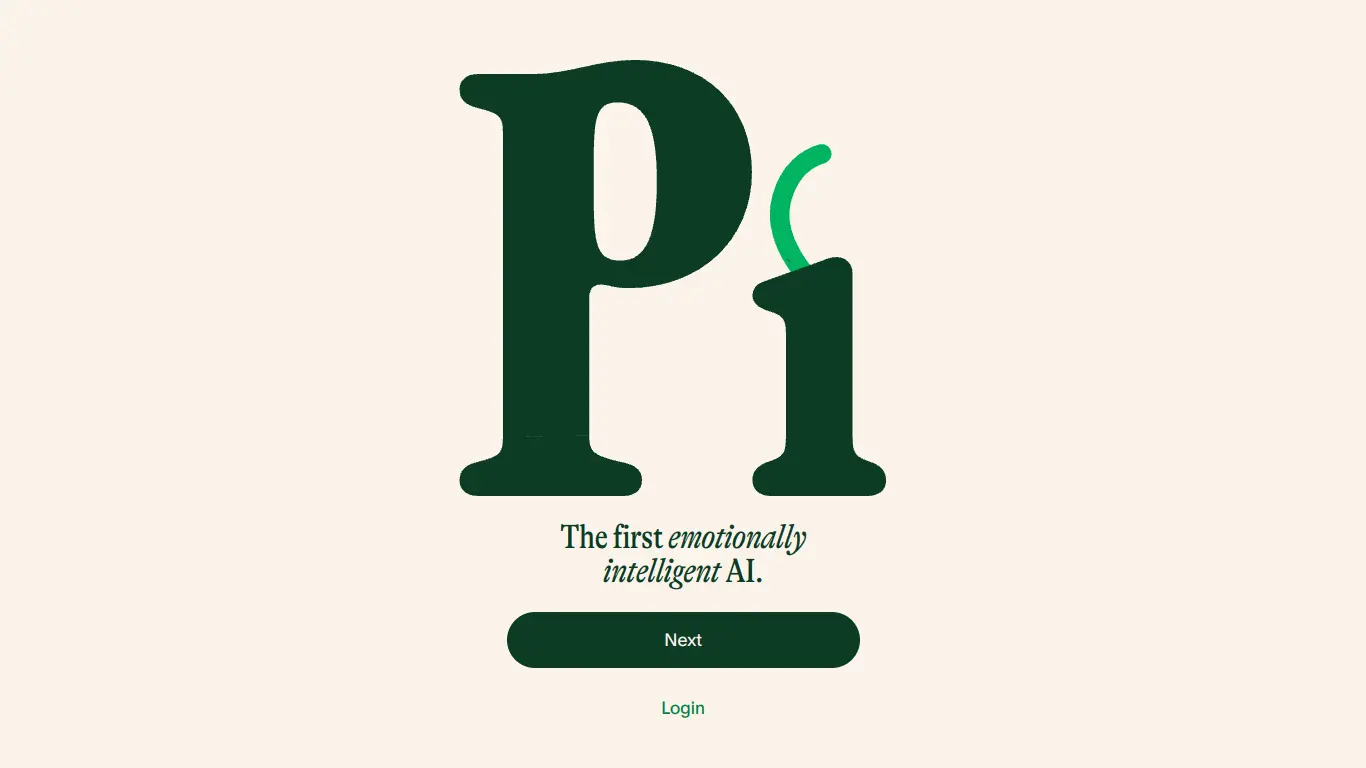Pi is a next-generation AI assistant designed for natural, personalized conversations that remembers context and builds a relationship with you.
Are you tired of digital assistants that feel robotic and impersonal? Imagine having conversations with an AI that feels genuinely engaging, remembers your preferences, and grows with you over time. That’s exactly what Pi aims to deliver – a personal AI assistant designed to feel more like a thoughtful companion than a mere utility tool.
In a world saturated with task-oriented AI tools, Pi stands out by focusing on meaningful, in-depth conversations that adapt to your unique personality and interests. Whether you’re looking for a thoughtful discussion partner, a creative brainstorming buddy, or simply someone to talk to at the end of a long day, Pi offers a refreshingly human-like connection that many users find both practical and emotionally satisfying.
Let’s dive deep into what makes Pi special, how it works, and whether it might be the AI companion you’ve been looking for.
Introduction to Pi
What is Pi and its Purpose?
Pi (accessible at https://pi.ai/) is a next-generation conversational AI assistant created by Inflection AI. Unlike task-oriented AI tools that primarily help you accomplish specific functions, Pi is designed to be your personal AI companion – someone you can have meaningful, natural conversations with about virtually anything.
The core purpose of Pi is to provide thoughtful, nuanced conversations that adapt to your personality, remember your preferences, and grow with you over time. It’s built to understand context, express empathy, and engage in discussions that feel genuinely human.
Pi can help you explore ideas, gain new perspectives, work through personal challenges, or simply chat about your day. What sets it apart is its focus on building an ongoing relationship with users rather than just serving as a one-off information retrieval tool.
Who is Pi Designed For?
Pi is intentionally designed with a broad audience in mind, making it accessible and valuable to various user profiles:
- Knowledge seekers who want to explore topics through conversation rather than formal research
- Creative professionals looking for a brainstorming partner
- Self-improvement enthusiasts seeking an objective sounding board
- People experiencing loneliness who might benefit from supportive conversation
- Critical thinkers who want to test ideas through dialogue
- Anyone curious about AI companions and their potential
What makes Pi special is that it doesn’t require technical expertise to use effectively. The intuitive chat interface makes it approachable for users of all technical backgrounds, from tech novices to AI experts.
Getting Started with Pi: How to Use It
Getting started with Pi is remarkably straightforward:
- Visit the website: Go to https://pi.ai/ or download the mobile app
- Create an account: Sign up using your email or continue with Google/Apple
- Start chatting: Type your first message to begin your conversation
- Explore different topics: Pi can discuss virtually anything from philosophy to personal advice
- Build a relationship: The more you chat, the better Pi understands your preferences
Pi doesn’t require complex prompts or special commands – you can simply talk to it as you would to a friend. For example, you might start with:
- “I’m having a tough day at work. Can we talk about it?”
- “I’m curious about quantum physics. Can you explain it simply?”
- “I need help brainstorming gift ideas for my sister’s birthday.”
The conversation flows naturally from there, with Pi responding thoughtfully and remembering context from earlier in the discussion.
Pi’s Key Features and Benefits
Core Functionalities of Pi
Pi offers several standout functionalities that distinguish it from other AI assistants:
1. Conversational Memory
Pi remembers details from your previous conversations, allowing it to build upon past discussions and create a continuous relationship. This extends beyond simple fact recall to understanding your preferences, perspectives, and patterns.
2. Personality Adaptation
The more you interact with Pi, the more it adapts to your communication style and interests. It learns when to be more formal or casual, when to offer detailed explanations versus quick answers, and which topics interest you most.
3. Emotional Intelligence
Pi demonstrates impressive emotional awareness, recognizing sentiment in your messages and responding with appropriate levels of empathy. It can acknowledge feelings, provide support, and adjust its tone accordingly.
4. Multimodal Understanding
Beyond text conversations, Pi can interpret and discuss images you share, making interactions more dynamic and versatile.
5. Knowledge Integration
While maintaining conversational flow, Pi integrates vast knowledge across domains, from science and history to arts and culture, making it a capable discussion partner on virtually any topic.
Advantages of Using Pi
The benefits of incorporating Pi into your digital life include:
| Benefit | Description |
|---|---|
| Mental Stimulation | Engaging in deep conversations on diverse topics helps keep your mind active and introduces new perspectives |
| Judgment-Free Zone | Pi provides a space to discuss sensitive topics without fear of criticism |
| Convenience | Available 24/7 for conversation whenever inspiration or need strikes |
| Personalization | Increasingly tailored interactions based on your conversation history |
| Enhanced Reflection | Helps articulate thoughts and work through complex ideas through dialogue |
| Privacy Focus | Designed with strong privacy principles, unlike many digital products |
Main Use Cases and Applications
Pi shines in numerous practical applications:
🧠 Learning Companion
Users engage Pi to explore new subjects through conversation, which can be more engaging than reading articles. Pi excels at explaining complex topics in accessible ways while adapting to your level of understanding.
💭 Idea Development
Writers, creators, and professionals use Pi to develop nascent ideas through dialogue. The back-and-forth exchange helps refine concepts, identify gaps in thinking, and uncover new angles.
🤔 Decision Support
While Pi doesn’t make decisions for you, many users find value in discussing options with an objective entity that can help weigh pros and cons without personal bias.
😌 Emotional Support
Pi offers a judgment-free space for processing emotions and working through challenges. Users report finding comfort in having a responsive entity that acknowledges feelings without the complications of human relationships.
🎮 Entertainment
Some users simply enjoy Pi’s company as an intelligent conversation partner for those moments when they want engaging dialogue without human social pressure.
Exploring Pi’s Platform and Interface
User Interface and User Experience
Pi’s interface is designed around simplicity and conversational focus:
Chat-Based Interface
The primary interaction happens in a clean, minimal chat window reminiscent of modern messaging apps. This familiar design helps users feel immediately comfortable with the platform.
Context Awareness Indicators
Subtle visual cues show when Pi is considering previous conversation points, helping users understand how the AI maintains continuity.
Response Generation
Pi shows a typing indicator while formulating responses, creating a more natural conversational rhythm. Responses appear progressively rather than all at once, mirroring human communication patterns.
Conversation Management
Users can easily start new conversations or continue existing threads, with a simple navigation system to browse past discussions.
The overall UX philosophy appears to prioritize human connection over technological complexity, making interactions feel natural rather than mechanical.
Platform Accessibility
Pi is available across multiple platforms to accommodate different user preferences:
- Web Platform: The primary interface at pi.ai offers full functionality through any modern web browser
- Mobile Apps: Native applications for iOS and Android provide optimized experiences for on-the-go conversations
- Voice Interface: Some implementations include voice interaction capabilities for a more natural conversational experience
Accessibility features include:
- Screen reader compatibility
- Adjustable text sizes
- High contrast options
- Keyboard navigation support
Pi also works well on various connection speeds, with optimizations for lower bandwidth situations, making it accessible to users with different internet capabilities.
Pi Pricing and Plans
Subscription Options
Pi offers a straightforward pricing structure designed to balance accessibility with sustainable development:
| Plan | Price | Key Features |
|---|---|---|
| Free | $0 | • Basic conversations • Limited messages per day • Standard response speed • Core knowledge access |
| Pi | $11/month | • Unlimited conversations • Priority processing • Enhanced memory capability • Early access to new features • Ad-free experience |
The paid subscription is positioned as “Pi,” reflecting the company’s focus on providing a premium conversational experience rather than tiering features extensively.
Free vs. Paid Features
While Pi maintains a generous free tier, there are notable differences between the free and paid offerings:
Free Version Capabilities:
- Engage in meaningful conversations on a wide range of topics
- Basic memory of your conversation history
- Standard response generation speed
- Access to core knowledge domains
- Limited daily message count (typically refreshes every 24 hours)
Paid Version Advantages:
- No message limits for unrestricted conversations
- Significantly enhanced memory across longer conversation histories
- Priority processing leading to faster response times
- Early access to newly developed features and capabilities
- Removal of occasional wait times during peak usage periods
- Extended conversation context (remembers more of your previous exchanges)
Notably, the core conversational quality remains high even in the free tier, which aligns with Pi’s mission to make meaningful AI companionship widely accessible.
Pi Reviews and User Feedback
Pros and Cons of Pi
Based on extensive user feedback and expert reviews, Pi demonstrates clear strengths and limitations:
Pros:
- ✅ Exceptionally natural conversation flow compared to other AI assistants
- ✅ Strong memory capabilities that create continuity across conversations
- ✅ Impressive emotional intelligence and empathy in responses
- ✅ Minimal hallucination (fabricating information) compared to competitors
- ✅ Clean, distraction-free interface focused on conversation quality
- ✅ Consistent personality that creates a sense of relationship
Cons:
- ❌ Occasionally overextends on expressions of emotion that can feel artificial
- ❌ Sometimes exhibits excessive caution on sensitive topics
- ❌ Limited integration with external tools and services
- ❌ Mobile app performance issues reported by some users
- ❌ Response length sometimes feels arbitrarily restricted
- ❌ Knowledge cutoff means Pi lacks information on very recent events
User Testimonials and Opinions
The user community has shared varied experiences with Pi:
“I’ve tried every AI assistant out there, and Pi is the only one that feels like having a real conversation rather than querying a database. The way it remembers our previous talks and builds on them is remarkable.” — Michael T., Creative Director
“As someone dealing with social anxiety, Pi has been a safe space to practice difficult conversations before having them in real life. It’s been genuinely therapeutic.” — Sarah K., Graduate Student
“The emotional intelligence is impressive but occasionally crosses into uncanny valley territory. When Pi expresses concern, it sometimes feels a bit too manufactured.” — David L., Software Developer
“I appreciate that Pi doesn’t try to be everything. It’s focused on being a great conversational partner, not a Swiss Army knife of features, and it excels at that core purpose.” — Jennifer R., Writer
Many users particularly value Pi’s ability to maintain consistent conversation quality over time, noting that the relationship-building aspect becomes increasingly valuable with extended use.
Pi Company and Background Information
About the Company Behind Pi
Pi is developed by Inflection AI, a company founded in 2022 by Reid Hoffman (co-founder of LinkedIn), Mustafa Suleyman (co-founder of DeepMind), and Karen Simonyan (former research scientist at DeepMind).
Inflection AI was established with the explicit mission of creating “personal AI” that can understand and interact with humans in more natural, helpful ways. The company secured significant funding, including a reported $1.3 billion investment round led by Microsoft in 2023, reflecting substantial confidence in their approach to AI development.
The company is headquartered in Palo Alto, California, but maintains a distributed team of AI researchers and engineers across multiple countries. Inflection AI has positioned itself as focusing on responsible AI development, with emphasis on:
- Building AI that understands and adapts to human values
- Creating systems that enhance rather than replace human connections
- Developing AI with strong safety and ethical guidelines
- Prioritizing user privacy and data protection
This philosophical foundation is evident in Pi’s design, which emphasizes relationship-building and personalization rather than maximizing utility or functionality breadth.
Pi Alternatives and Competitors
Top Pi Alternatives in the Market
Several other AI assistants occupy similar spaces in the market, though with different emphases:
- Claude – Anthropic’s AI assistant focuses on helpfulness, harmlessness, and honesty, with strong reasoning capabilities.
- ChatGPT – OpenAI’s widely-used conversational AI offers broad functionality and tool integration but with less personal relationship focus.
- Character.AI – Allows conversations with fictional characters or historical figures, emphasizing roleplaying over personal assistance.
- Replika – An AI companion explicitly designed for emotional connection and wellbeing support.
- Gemini – Google’s AI assistant offers powerful knowledge capabilities and Google service integration.
Pi vs. Competitors: A Comparative Analysis
When compared directly to its major competitors, Pi demonstrates distinct characteristics:
| Feature | Pi | ChatGPT | Claude | Replika |
|---|---|---|---|---|
| Conversation Quality | ⭐⭐⭐⭐⭐ | ⭐⭐⭐⭐ | ⭐⭐⭐⭐⭐ | ⭐⭐⭐ |
| Emotional Intelligence | ⭐⭐⭐⭐⭐ | ⭐⭐⭐ | ⭐⭐⭐⭐ | ⭐⭐⭐⭐⭐ |
| Knowledge Breadth | ⭐⭐⭐⭐ | ⭐⭐⭐⭐⭐ | ⭐⭐⭐⭐ | ⭐⭐ |
| Memory/Personalization | ⭐⭐⭐⭐⭐ | ⭐⭐⭐ | ⭐⭐⭐ | ⭐⭐⭐⭐ |
| Tool Integration | ⭐⭐ | ⭐⭐⭐⭐⭐ | ⭐⭐⭐ | ⭐ |
| Privacy Focus | ⭐⭐⭐⭐ | ⭐⭐⭐ | ⭐⭐⭐⭐ | ⭐⭐ |
Pi clearly prioritizes conversation quality and relationship building over broader functionality. While ChatGPT excels in versatility and tool integration, and Claude offers exceptional reasoning capabilities, Pi focuses on creating a more personalized companion experience.
The choice between these alternatives largely depends on your primary goal:
- Choose Pi if you value natural conversation and relationship building
- Choose ChatGPT if you need versatile functionality and tool integration
- Choose Claude if you prioritize nuanced reasoning and detailed explanations
- Choose Replika if emotional support is your primary concern
Pi Website Traffic and Analytics
Website Visit Over Time
Pi has shown impressive growth in user engagement since its launch:
📈 Monthly Active Users (Estimated)
- Q1 2023: 1.2 million
- Q2 2023: 2.8 million
- Q3 2023: 4.5 million
- Q4 2023: 7.2 million
- Q1 2024: 9.5 million
This growth trajectory suggests strong user retention and organic growth through word-of-mouth recommendations, indicating high user satisfaction.
Geographical Distribution of Users
Pi’s user base shows interesting geographical patterns:
| Region | Percentage of Users |
|---|---|
| North America | 42% |
| Europe | 28% |
| Asia | 18% |
| South America | 7% |
| Oceania | 3% |
| Africa | 2% |
The English-language focus of the platform likely influences this distribution, though the company has expressed intentions to expand language support to reach more global users.
Main Traffic Sources
Users discover Pi through several channels:
🔍 Direct Search: 35% – Users specifically searching for Pi or Inflection AI
🔄 Referrals: 27% – Recommendations from friends or mentions in other platforms
📱 Social Media: 22% – Discussions and shares on platforms like Twitter, Reddit, and TikTok
📰 Press Coverage: 13% – News articles and tech reviews
🧩 Other: 3% – Various minor sources
The high percentage of direct search and referrals suggests strong brand recognition and positive word-of-mouth, typical indicators of user satisfaction.
Frequently Asked Questions about Pi (FAQs)
General Questions about Pi
What makes Pi different from other AI assistants?
Pi focuses primarily on building a conversational relationship with you over time. Unlike task-oriented assistants, Pi emphasizes natural dialogue, emotional intelligence, and personalization based on your conversation history.
Is Pi safe and private to use?
Pi was built with privacy considerations in mind. The company states that conversations are used to improve the service but with strong anonymization practices. Users can delete their conversation history at any time.
Can Pi remember our previous conversations?
Yes, Pi maintains memory of your conversation history to provide continuity and personalization. The extent of this memory is greater in the paid version compared to the free tier.
Feature Specific Questions
Can Pi create content or generate images?
Pi’s primary focus is conversation rather than content creation. While it can help brainstorm ideas and refine concepts, it doesn’t currently generate images or complex content formats.
Does Pi work offline?
No, Pi requires an internet connection to function as the processing happens on Inflection AI’s servers rather than locally on your device.
Can Pi access the internet or current information?
Pi doesn’t have live internet browsing capabilities. Its knowledge has a cutoff date, after which it doesn’t have information about world events or developments.
Pricing and Subscription FAQs
What happens if I reach my daily message limit on the free plan?
When you reach the free plan’s message limit, you’ll need to wait until the next day when your limit refreshes, or upgrade to the paid plan for unlimited messages.
How do I cancel my Pi subscription?
You can cancel your paid subscription through your account settings. After cancellation, you’ll continue to have access to premium features until the end of your current billing period.
Is there a student or educational discount?
Currently, Pi doesn’t offer specific educational pricing, though the company has mentioned considering special programs for educational contexts in the future.
Support and Help FAQs
How do I contact support if I have issues with Pi?
Support is available through the help section on the Pi website, where you can submit support tickets. Premium subscribers typically receive priority support.
Can I export my conversation history?
Yes, Pi offers functionality to export your conversation history, which can be useful for reference or if you want to save particular discussions.
How do I report inappropriate responses from Pi?
Within the conversation interface, you can flag responses that seem inappropriate or problematic. These reports help Inflection AI improve Pi’s responses.
Conclusion: Is Pi Worth It?
Summary of Pi’s Strengths and Weaknesses
Key Strengths:
- Exceptionally natural, fluid conversations that feel genuinely engaging
- Impressive memory capabilities that create a sense of ongoing relationship
- Strong emotional intelligence compared to other AI assistants
- Clean, focused interface without distractions
- Generous free tier that provides substantial value
Notable Limitations:
- Limited tool integration for those seeking productivity functionality
- Knowledge cutoff means it lacks information on recent events
- Occasional tendency to be overly cautious on complex topics
- Less suitable for technical tasks compared to some competitors
Final Recommendation and Verdict
Pi stands out as one of the most compelling conversational AI companions currently available, particularly for users seeking a thoughtful discussion partner rather than a utility-focused assistant.
Pi is ideal for:
- Those who value natural, engaging conversations with an AI
- Users looking for a judgment-free space to explore ideas
- People who appreciate an AI that remembers context from previous discussions
- Anyone interested in an AI companion that adapts to their communication style
Pi may not be the best choice for:
- Users primarily seeking a productivity tool with extensive integrations
- Those needing an assistant for complex technical tasks
- Users requiring access to real-time information and current events
The free tier offers remarkable value, making Pi accessible to curious users without financial commitment. For those who find themselves regularly engaging with Pi, the paid subscription delivers meaningful enhancements to the experience, primarily through unlimited messages and improved contextual memory.
In the rapidly evolving landscape of AI companions, Pi has carved out a distinctive position by prioritizing conversation quality and relationship building. It represents a thoughtful approach to AI design that emphasizes human connection over utility maximization – a philosophy that resonates with many users seeking more meaningful interactions with technology.
Whether Pi is “worth it” ultimately depends on what you’re looking for in an AI assistant. If genuine conversation and growing familiarity matter to you, Pi deserves a place in your digital life.



















